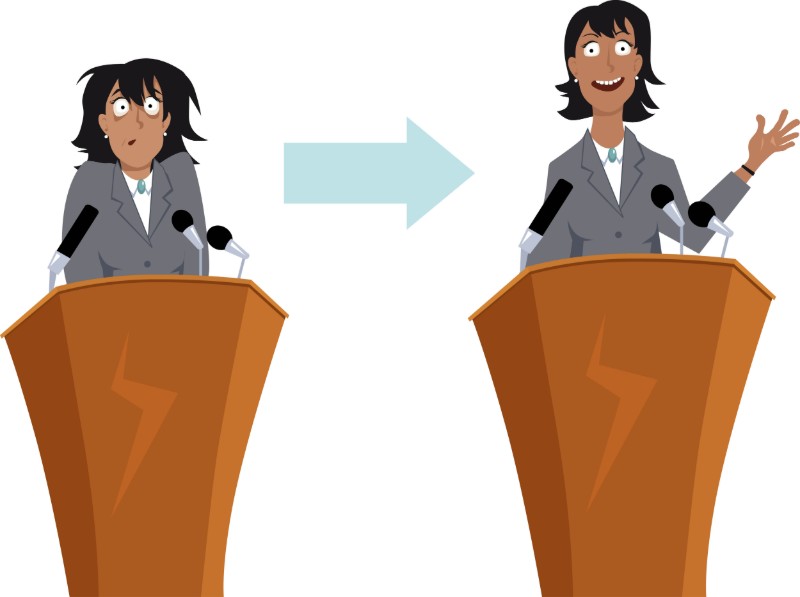The ability to speak clearly and confidently about your art can be an important factor in your success. From talking to a prospective gallerist or agent, to speaking at an international arts event and meeting collectors at an art fair, the ability to distil your work and your vision into words is critically important. Effective public speaking and confident networking can increase your visibility in a crowded marketplace and create a competitive edge in your career. So, if you’re anxious at the mere thought of giving an artist’s talk, read on!
We know that around 70% of people experience public speaking anxiety and many people are naturally shy. The good news is that there are some simple strategies you can use to enhance your speaking ability and reduce your communication nervousness – all it takes is a little work and lots of practice. Here are our 15 Top Tips to help you improve your public speaking skills and increase your communication confidence.
1. Turn that nervous energy into enthusiasm!
Everyone feels a little anxious standing up to make a speech but don’t let nervousness be the saboteur of your presentation. It’s important to take control. Acknowledge those nervous feelings but tell yourself it’s just excitement. It might still feel the same but the emotion is much more positive. Try to focus on your breathing when you’re feeling nervous. Breathing deeply and slowly will help you to stay calm; it also increases your vocal control and enables you to project your voice more clearly. Your speaking anxiety will diminish with practice but even the most experienced speakers still feel a few butterflies in the tummy. This sense of anticipation adds a little sparkle to your presentation, just as most performers feel a touch of nerves before they take to the stage.
2. THINK OF IT AS A CONVERSATION NOT A SPEECH.
Most people are not so nervous when talking one-on-one about their work, so try to think of a presentation as just a conversation with more people. This technique also helps make your presentation more naturalistic and less formal. Try to structure your thoughts to move from the general to the specific, say from general thoughts about writing and publishing to specific ideas about YA fiction.

Image: Shutterstock
3. Use confident body language.
The audience is watching as well as listening, so be aware of your body language and non-verbal communication. Nervous mannerisms such as gripping the podium or clenching your fists are distracting and undermine what you’re saying. Don’t fidget, fiddle with your clothing, or put your hands in your pockets. Face the audience, take a deep breath, and smile for a moment before you speak. Don’t read your presentation word-for-word; look down at your notes when needed and then back at the audience, making eye contact whenever you can – you are speaking to people, not at them. And always remember that you are the expert on your work.
4. First Impressions are important.
Be aware that the audience sees you before they hear you; you need to project an aura of confidence even if you don’t feel it. Your personal presence is an important part of a professional presentation. This isn’t about being well-dressed or acting like someone else; it’s about being your best self and being authentic. Being fully present in the moment is an engaging quality and always captures the audience’s attention. Try to stay completely focused on the audience and not be distracted by nervousness or other concerns.
5. Never begin with an apology!
It’s tempting for a nervous or inexperienced speaker to begin by saying, ‘Sorry, I’m really nervous, so I hope this is OK’. This is absolutely the worst thing you can do! If you don’t tell the audience you’re nervous, they will probably never realise it. Begin with a smile and a positive opening and the audience is on your side immediately.

Image: Shutterstock
6. Say it loud!
It’s important to be comfortable with the sound of your own voice and to speak with precision and clarity. Make time at home to practise speaking out loud. Read a few pages from a book or an ArtsHub article and really listen to your voice. Articulate the words clearly and experiment with your pitch, pace, and volume. Most people speak faster than usual when they’re nervous, so be aware of this and slow down a little. An anxious voice also tends to sound higher and thinner than your regular voice, so try to lower your pitch. Lower and slower are the keywords for effective speaking. Aim for around 120 words a minute in a prepared speech. This pace gives your audience time to listen, think, and absorb what you’re saying; it also makes you sound confident and in control.
7. The power of the pause.
If there is one single technique that gives your public speaking clarity and credibility, it’s this: learn to appreciate the power of the pause. An inexperienced speaker just keeps speaking because they’re afraid of silence, just as we all dread the awkward pause on a first date. An experienced speaker knows that a well-placed pause is the best way to underline a key point and add emphasis to their argument.
8. It’s a can of worms.
Try to avoid clichés, jargon, empty phrases, and gobbledygook in your presentations. Don’t say ‘at this point in time’ if you mean ‘now’. Don’t waffle or ramble, saying ‘Then I did this…and then I did that…and then this’. And try to eliminate vocal fillers such as ‘Umm’, ’err’, ‘ahhh’, and ‘you know’. We use these fillers all the time but they are really irritating for the audience. Become aware of the fillers you use regularly and banish them from your conversation.
9. Be prepared.
Public speaking coaches often refer to The 5Ps: Proper Preparation Prevents Poor Presentations! Being well-prepared gives you an inner confidence when you speak and communicates authority and credibility.

Image: Shutterstock
10. HAVE A CLEAR COMMUNICATION GOAL.
Whether it’s a presentation at an arts conference or a meeting with the local council about a new grant, you should have a clear communication goal. Defining your goal will help you focus your presentation. It will enable you to say what you need to say and no more – knowing when to stop is always important! All presentations are a blend of information, persuasion, and entertainment. The right mix depends on the situation but remember that a presentation that is purely informative is likely to be dull. It is the element of entertainment that makes a speech engaging. This doesn’t mean you should tell jokes or try to be amusing. The element of entertainment comes from having a conversational approach to your topic and using interesting, relevant anecdotes to illustrate your points. In the same way, a persuasive presentation still needs facts to give it substance. You only need three or four main points, then gather the ideas and information to support them. And don’t be shy about drawing attention to your main points: ‘Let me tell you why this is so important…’
11. Be a Storyteller.
In conversation and in presentations, use every opportunity to tell your own story. Always make it authentic and true to you. This is your story, the story of your work and your inspiration, your ideas and your ambitions, so be passionate. Create a well-crafted introduction and get to what really matters to you. Don’t waste time on the minutiae. Aim to highlight both your uniqueness and your universality and strive to communicate authority, authenticity, and credibility. Show your enthusiasm and be sincere. Tell stories that illustrate key aspects of your creative practice. Don’t be afraid to share your thoughts and feelings. Approach every opportunity to speak with energy, optimism and enthusiasm and remember that an audience can soon tell if you are being insincere or disingenuous.
12. Create Word Pictures.
It’s always important to bring your words to life; if you don’t, your audience will be distracted by trying to work it out for themselves. Use clear word pictures to explain and clarify your points, such as, ‘The exhibition space will be 60 metres long – that’s about the length of three cricket pitches’.

Image: Shutterstock
13. Involve the Audience.
Whether it’s a job interview or a major conference speech, it’s important to know what the audience wants to hear. Find ways to involve your audience so everything you say resonates with them. Audiences respond emotionally to a speaker before they respond intellectually. ‘She was good’; ‘I liked him’; ‘She knew what she was talking about’ and ‘I didn’t trust them’ are typical emotional responses. These responses are often determined by how you speak, rather than what you say.
14. Develop an Elevator Pitch.
The idea of an ‘elevator pitch’ is to encapsulate your story into just a few sentences. Work on this so you can tell someone who you are and what you do clearly and succinctly. And always be ready to talk about your art. There may be times when you are called on spontaneously to ‘say a few words’ and being able to respond smoothly is important. Include a few key background details and highlight any awards or recognition you have received. Add a few words about your vision and process, and you’re done. The ability to think on your feet, and then communicate effectively, is an important life skill, so take the time to make it work for you.
15. Create opportunities to talk about your work.
Every time you speak, your confidence increases and your anxiety decreases. This change may only be incremental, but it will be noticeable over time. Unfortunately, we all have a tendency to avoid things that make us uncomfortable. Instead, try embracing every opportunity to talk about your work. Going to a meeting at the local writers group? Introduce yourself to the group; ask questions at the meeting; or volunteer for a new role. These are all small ways to enhance your communication confidence. And when you do make a presentation, remember to engage in a little self-evaluation. What worked well? What didn’t sound so good? Be objective but also be gentle with yourself as you learn and grow.
Developing your public speaking skills will also enhance your everyday communication as you learn to speak with more focus, colour, and clarity. You will also become more confident about speaking in difficult situations. As the writer and philosopher Ralph Waldo Emerson observed: ‘All the great speakers were bad speakers first’.





